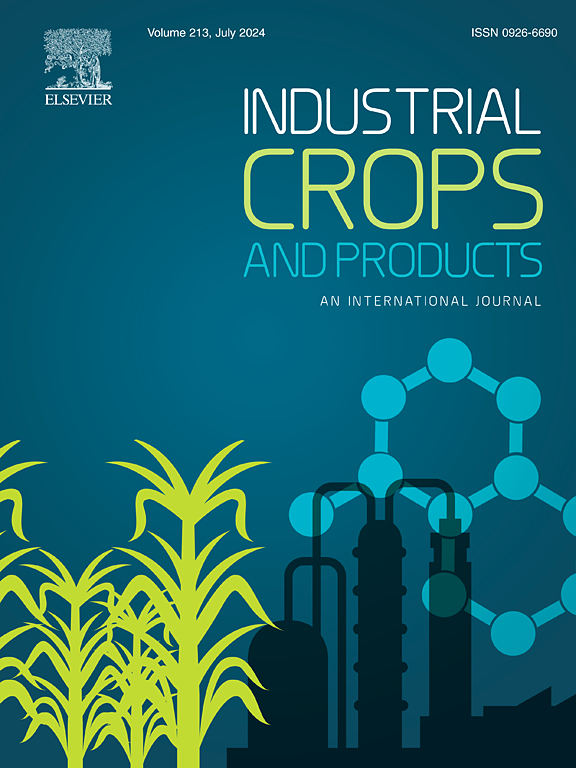Insight into the production factors influencing the physicochemical properties of densified briquettes comprising wood shavings and rice husk
IF 5.6
1区 农林科学
Q1 AGRICULTURAL ENGINEERING
引用次数: 0
Abstract
The present work aims at elucidating the impact of various densification parameters on the physicochemical and combustion properties of fuel briquettes issued from the co-processing of wood shavings (W) and rice husks (RH) using a mechanical piston press machine. To that end, a design of experiments integrating three feeding speeds (15.76, 18.56, and 21.73 mm·s−1), two wood particle sizes (< 7 mm and between 7 and 10 mm) and six different RH contents ranging from 0 to 100 wt% was built. The obtained results showed that all the above operating factors influence the apparent density of the produced briquettes. Values ranging from 1143 to 1247 kg·m−3 were notably measured, with the highest one determined when considering a low feeding speed, small wood particles and an RH proportion of 80 wt%. While increasing the RH content led to an increase in the briquette density, the obtained results also showed that the higher the RH content, the lower the water resistance index. Measured values indeed went from 94 % on average for pure wood to ⁓85 % for pure RH, attesting to the potential challenge associated with the storage of briquettes containing high RH contents. As for the net calorific value, it was shown to rise from ⁓11 to ⁓ 16 MJ·kg−1 when varying the proportion of wood between 0 and 100 wt%. This trend was especially traced to an increase of the wt% of volatile matters in the produced briquettes accompanied by a decrease of their ash content. Combustion tests performed with different briquette samples then allowed inferring burning rates between 10.9 and 13.4 g·min−1, specific fuel consumptions ranging from 115.8 to 138.4 g·l−1 and combustion efficiencies of around 12 %. As highlights, these tests demonstrated that the higher the wood content, the higher the burning rate, the lower the specific fuel consumption and the higher the combustion efficiency. Finally, two tested briquette formulations containing 80 and 100 wt% of wood were shown to have better combustion properties than a commercial firewood used for comparison. Total greenhouse gas (CO2 and CH4) emissions were even found to be reduced by 9.4 % when burning the RH-containing sample instead of firewood, while providing the same amount of sensible heat to a 3-l volume of water. These findings thus highlight the potential interest of beneficiating biomass wastes into briquettes for heat generation, further noting that the development of this type of alternative energy carrier offers multiple advantages in terms of waste management, reduction of the deforestation induced by the intensive use of firewood and mitigation of climate change through a potential reduction greenhouse gas emissions.
深入了解影响木屑和稻壳组成的致密型煤理化性质的生产因素
本研究旨在阐明不同致密化参数对机械活塞压力机协同加工木屑(W)和稻壳(RH)产生的燃料型煤的物理化学和燃烧特性的影响。为此,设计了三种进料速度(15.76、18.56和21.73 mm·s−1)、两种木材粒径(<;7 mm和7 ~ 10 mm)和6种不同的RH含量,范围为0 ~ 100 wt%。试验结果表明,上述操作因素均影响所制成型煤的表观密度。测量值范围为1143 ~ 1247 kg·m−3,当考虑到低进料速度、小木材颗粒和80 wt%的相对湿度时,测量值最高。RH含量的增加导致型煤密度的增加,但结果也表明,RH含量越高,水阻指数越低。测量值确实从纯木材的平均94 %到纯RH的⁓85 %,证明了与含有高RH含量的型煤储存相关的潜在挑战。当木材比例在0 ~ 100 wt%之间变化时,净热值从⁓11增加到⁓16 MJ·kg−1。这一趋势特别可追溯到所生产的型煤中挥发物的wt%增加,同时灰分含量减少。用不同型煤样品进行的燃烧试验可以推断出燃烧速率在10.9至13.4 g·min - 1之间,比燃料消耗量在115.8至138.4 g·min - 1之间,燃烧效率约为12% %。作为重点,这些试验表明,木材含量越高,燃烧速度越快,比油耗越低,燃烧效率越高。最后,两种测试型煤配方含有80%和100% wt%的木材被证明比用于比较的商业木柴具有更好的燃烧性能。当燃烧含rh的样品而不是木柴时,温室气体(CO2和CH4)排放总量甚至减少了9.4% %,同时为3-l体积的水提供相同数量的显热。因此,这些研究结果突出了将生物质废物选矿成用于供热的压块的潜在利益,并进一步指出,开发这类替代能源载体在废物管理、减少木柴集约使用导致的森林砍伐和通过可能减少温室气体排放缓解气候变化方面具有多重优势。
本文章由计算机程序翻译,如有差异,请以英文原文为准。
求助全文
约1分钟内获得全文
求助全文
来源期刊

Industrial Crops and Products
农林科学-农业工程
CiteScore
9.50
自引率
8.50%
发文量
1518
审稿时长
43 days
期刊介绍:
Industrial Crops and Products is an International Journal publishing academic and industrial research on industrial (defined as non-food/non-feed) crops and products. Papers concern both crop-oriented and bio-based materials from crops-oriented research, and should be of interest to an international audience, hypothesis driven, and where comparisons are made statistics performed.
 求助内容:
求助内容: 应助结果提醒方式:
应助结果提醒方式:


